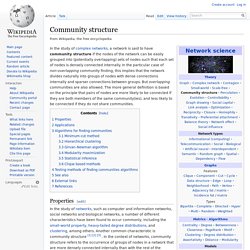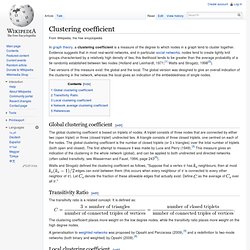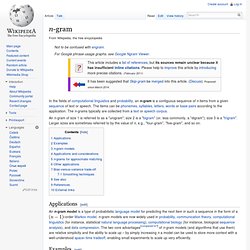

Overview — NetworkX 1.6 documentation. Data Visualization Software. Graph-tool. Pdf/1012.2774.pdf. Krebs. This paper looks at mapping covert networks using data available from news sources on the World Wide Web.

Specifically, we examine the network surrounding the tragic events of September 11th 2001. Through public data we are able to map a portion of the network centered on the 19 dead hijackers. This map gives us some insight into the terrorist organization, yet it is incomplete. Suggestions for further work and research are offered. Contents Introduction and BackgroundData GatheringPrevention or Prosecution? Figure 2 I was amazed at how sparse the network was and how distant many of the hijackers on the same team were from each other. "Those who were trained to fly didn't know the others. The network metrics for the network in Figure 2 are found in Table 1.
A Great Cities Initiative of the University of Illinois at Chicago University Library. Www.ams.org/notices/200909/rtx090901082p.pdf. Community structure. In the study of complex networks, a network is said to have community structure if the nodes of the network can be easily grouped into (potentially overlapping) sets of nodes such that each set of nodes is densely connected internally.

In the particular case of non-overlapping community finding, this implies that the network divides naturally into groups of nodes with dense connections internally and sparser connections between groups. But overlapping communities are also allowed. The more general definition is based on the principle that pairs of nodes are more likely to be connected if they are both members of the same community(ies), and less likely to be connected if they do not share communities. Properties[edit] Complex systems. Complex systems present problems both in mathematical modelling and philosophical foundations.

The study of complex systems represents a new approach to science that investigates how relationships between parts give rise to the collective behaviors of a system and how the system interacts and forms relationships with its environment.[1] Network theory. A small example network with eight vertices and ten edges.

It has applications in many disciplines including statistical physics, particle physics, computer science, electrical engineering, biology, economics, operations research, and sociology. Network science. {{Scienc[1] e}} Network science is an interdisciplinary academic field which studies complex networks such as telecommunication networks, computer networks, biological networks, cognitive and semantic networks, and social networks.

The field draws on theories and methods including graph theory from mathematics, statistical mechanics from physics, data mining and information visualization from computer science, inferential modeling from statistics, and social structure from sociology. The United States National Research Council defines network science as "the study of network representations of physical, biological, and social phenomena leading to predictive models of these phenomena. Complex network. Clustering coefficient. In graph theory, a clustering coefficient is a measure of the degree to which nodes in a graph tend to cluster together.

Evidence suggests that in most real-world networks, and in particular social networks, nodes tend to create tightly knit groups characterised by a relatively high density of ties; this likelihood tends to be greater than the average probability of a tie randomly established between two nodes (Holland and Leinhardt, 1971;[1] Watts and Strogatz, 1998[2]). Two versions of this measure exist: the global and the local. The global version was designed to give an overall indication of the clustering in the network, whereas the local gives an indication of the embeddedness of single nodes. Global clustering coefficient[edit] Exploring complex networks : Article : Nature. Steven H.

Strogatz Networks are on our minds nowadays. Sometimes we fear their power — and with good reason. On 10 August 1996, a fault in two power lines in Oregon led, through a cascading series of failures, to blackouts in 11 US states and two Canadian provinces, leaving about 7 million customers without power for up to 16 hours1. The Love Bug worm, the worst computer attack to date, spread over the Internet on 4 May 2000 and inflicted billions of dollars of damage worldwide.
In our lighter moments we play parlour games about connectivity. Meanwhile scientists have been thinking about networks too. Figure 1: Wiring diagrams for complex networks. a, Food web of Little Rock Lake, Wisconsin, currently the largest food web in the primary literature5. High resolution image and legend (73K) Why is network anatomy so important to characterize? N-gram. An n-gram of size 1 is referred to as a "unigram"; size 2 is a "bigram" (or, less commonly, a "digram"); size 3 is a "trigram".

Larger sizes are sometimes referred to by the value of n, e.g., "four-gram", "five-gram", and so on. Applications[edit] An n-gram model is a type of probabilistic language model for predicting the next item in such a sequence in the form of a –order Markov model. n-gram models are now widely used in probability, communication theory, computational linguistics (for instance, statistical natural language processing), computational biology (for instance, biological sequence analysis), and data compression. The two core advantages[compared to?] Examples[edit] Figure 1 shows several example sequences and the corresponding 1-gram, 2-gram and 3-gram sequences.
Как отслеживать частоту применения слов с помощью Ngram Viewer? Ngram Viewer.